Noise Reduction Study of Pressure Pulsation in Pumped Storage Units Based on Sparrow Optimization VMD Combined with SVD
Abstract
:1. Introduction
2. Methods
2.1. VMD
- (1)
- Mode components of the analytic signal
- (2)
- Estimation of the frequency bandwidth of each intrinsic mode function
- (3)
- Introduction of the Lagrange quadratic constraint and solution using alternating operators
- (4)
- Termination conditions
2.2. Adaptive Optimization of VMD Parameters
2.2.1. SSA Principles
2.2.2. VMD Parameter Optimization Based on SSA
2.3. PE
- (1)
- Suppose a time series and reconstruct its phase space; the matrix is obtained as follows:where is the embedding dimension and is the delay time. is the number of row vectors to reconstruct.
- (2)
- Each row of the matrix is considered as a reconstructed component, and the elements are rearranged in ascending order to obtain:where ,is the column index of each element in the reconstructed component.
- (3)
- Calculate the probability of indexing at different positions. Define the normalized PE of the indexed series at different positions of the time series according to the form of entropy.
2.4. SVD
2.5. Noise Reduction Steps
3. Results
3.1. Simulation Signal
3.2. Vibration Signal Analysis
3.3. Noise Reduction Based on SSA–VMD–SVD
3.3.1. Fitness Function
3.3.2. Optimization Algorithms
3.3.3. PE Parameter
3.3.4. The Comparison of Entropy
3.3.5. Simulation Results
4. Discussion
4.1. Comparison of Methods
4.1.1. Comparative Analysis
4.1.2. Effectiveness Evaluation
4.2. Analysis of Variable Working Conditions
4.3. Examples
5. Conclusions
- (1)
- Applying the SSA algorithm with envelope entropy as the fitness function to the parameter decomposition of VMD overcomes the shortcomings of manual parameter selection of VMD and realizes the adaptive decomposition of VMD.
- (2)
- The choice of the combined VMD–SVD noise reduction method effectively avoids the problem of post-reconstruction noise interference and can achieve good results in non-stationary signal decomposition.
- (3)
- Through simulation comparison with CEEMD–PE, VMD–PE, ALIF–PE, and ALIF–SVD, it is proved that the noise reduction method of VMD–SVD can effectively remove noise, achieve the extraction of low frequency fault characteristics of pressure pulsation of pumped storage units under strong noise disturbance, and enhance fault-related characteristics.
Author Contributions
Funding
Institutional Review Board Statement
Informed Consent Statement
Data Availability Statement
Conflicts of Interest
References
- Han, T.; Li, Y.F.; Qian, M. A Hybrid Generalization Network for Intelligent Fault Diagnosis of Rotating Machinery Under Unseen Working Conditions. IEEE Trans. Instrum. Meas. 2021, 70, 1–11. [Google Scholar] [CrossRef]
- Cai, B.; Hao, K.; Wang, Z.; Yang, C.; Kong, X.; Liu, Z.; Ji, R.; Liu, Y. Data-driven early fault diagnostic methodology of permanent magnet synchronous motor. Expert Syst. Appl. 2021, 177, 115000. [Google Scholar] [CrossRef]
- Liu, T.; Wang, C.; Chen, Z.; Chen, F.; Bi, H.; Luo, Y.; Wang, Z. Analysis of flow characteristics in pumped storage unit during start-up in turbine mode. J. Phys. Conf. Ser. 2021, 1985, 012051. [Google Scholar] [CrossRef]
- Jowsey, E. A new basis for assessing the sustainability of natural resources. Energy 2007, 32, 906–911. [Google Scholar] [CrossRef]
- Feng, Z.; Chu, F. Nonstationary Vibration Signal Analysis of a Hydroturbine Based on Adaptive Chirplet Decomposition. Struct. Health Monit. Int. J. 2007, 6, 265–279. [Google Scholar] [CrossRef]
- Cai, B.; Liu, Y.; Xie, M. A Dynamic-Bayesian-Network-Based Fault Diagnosis Methodology Considering Transient and Intermittent Faults. IEEE Trans. Autom. Sci. Eng. 2017, 6, 11289–11300. [Google Scholar] [CrossRef]
- Ren, Y.; Huang, J.; Hu, L.-M.; Chen, H.-P.; Li, X.-K. Research on Fault Feature Extraction of Hydropower Units Based on Adaptive Stochastic Resonance and Fourier Decomposition Method. Shock Vib. 2021, 2021, 6640040. [Google Scholar] [CrossRef]
- Delina, M.; Nurhusni, P.A. Feature extraction of noise signal in motorcycle by Fast Fourier Transform. J. Phys. Conf. Ser. 2021, 1869, 12198. [Google Scholar] [CrossRef]
- Guan, S.; Wang, X.; Hua, L.; Li, L. Quantitative ultrasonic testing for near-surface defects of large ring forgings using feature extraction and GA-SVM. Appl. Acoust. 2021, 173, 107714. [Google Scholar] [CrossRef]
- Rybak, G.; Strzecha, K. Short-Time Fourier Transform Based on Metaprogramming and the Stockham Optimization Method. Sensors 2021, 21, 4123. [Google Scholar] [CrossRef]
- Chui, C.K.; Jiang, Q.; Li, L.; Lu, J. Analysis of an adaptive short-time Fourier transform-based multicomponent signal separation method derived from linear chirp local approximation. J. Comput. Appl. Math. 2021, 396, 113607. [Google Scholar] [CrossRef]
- Li, Y.; Wang, Z.; Li, Z.; Li, H. Research on Gear Signal Fault Diagnosis Based on Wavelet Transform Denoising. J. Phys. Conf. Ser. 2021, 1971, 012074. [Google Scholar] [CrossRef]
- Zhang, K.; Ma, C.; Xu, Y.; Chen, P.; Du, J. Feature extraction method based on adaptive and concise empirical wavelet transform and its applications in bearing fault diagnosis. Measurement 2021, 172, 108976. [Google Scholar] [CrossRef]
- Zhang, K.; Tian, W.; Chen, P.; Ma, C.; Xu, Y. Sparsity-guided multi-scale empirical wavelet transform and its application in fault diagnosis of rolling bearings. J. Braz. Soc. Mech. Sci. Eng. 2021, 43, 1–17. [Google Scholar] [CrossRef]
- Pal, S.; Mitra, M. Empirical mode decomposition based ECG enhancement and QRS detection. Comput. Biol. Med. 2012, 42, 83–92. [Google Scholar] [CrossRef]
- Jiang, Z.; Wu, Y.; Li, J.; Liu, Y.; Xu, X. Application of EMD and 1.5-dimensional spectrum in fault feature extraction of rolling bearing. J. Eng. 2019, 2019, 8843–8847. [Google Scholar] [CrossRef]
- Chen, Y.; Sun, J. Fault Diagnosis of Rolling Bearing Based on EEMD and PSO-SVM. Electr. Power Sci. Eng. 2016, 32, 47. [Google Scholar]
- Liu, X.; Zhang, X.; Luan, Z.; Xu, X. Rolling bearing fault diagnosis based on EEMD sample entropy and PNN. J. Eng. 2019, 2019, 8696–8700. [Google Scholar] [CrossRef]
- Wang, W.; Chen, Q.; Yan, D.; Geng, D. A novel comprehensive evaluation method of the draft tube pressure pulsation of Francis turbine based on EEMD and information entropy. Mech. Syst. Signal Process. 2019, 116, 772–786. [Google Scholar] [CrossRef]
- An, X.; Zeng, H.; Li, C. Demodulation analysis based on adaptive local iterative filtering for bearing fault diagnosis. Measurement. 2016, 94, 554–560. [Google Scholar] [CrossRef]
- Zhao, L.; Liu, X.; Lou, L. The feature extraction method of non-stationary vibration signal based on SVD-complex analytical wavelet demodulation. Zhendong Ceshi Yu Zhenduan/J. Vib. Meas. Diagn. 2015, 35, 672–676. [Google Scholar]
- Ren, Y.; Liu, P.; Hu, L.; Huang, J.; Huang, S. Research on Noise Reduction Method of Pressure Pulsation Signal of Draft Tube of Hydropower Unit Based on ALIF-SVD. Shock Vib. 2021, 2021, 5580319. [Google Scholar] [CrossRef]
- Bai, Y.; Liu, M.D.; Ding, L.; Ma, Y.J. Double-layer staged training echo-state networks for wind speed prediction using variational mode decomposition. Appl. Energy 2021, 301, 117461. [Google Scholar] [CrossRef]
- Gfa, B.; Hwa, B.; Tqa, B.; Xpa, B.; Hong, W.C. A Transient Electromagnetic Signal Denoising Method Based on An Improved Variational Mode Decomposition Algorithm—ScienceDirect. Measurement 2021, 184, 109815. [Google Scholar]
- Zhu, X.; Huang, Z.; Chen, J.; Lu, J. Rolling bearing fault diagnosis method based on VMD and LSSVM. J. Phys. Conf. Ser. 2021, 1792, 12035. [Google Scholar] [CrossRef]
- Zhang, Y.; Lian, Z.; Fu, W.; Chen, X. An ESR Quasi-Online Identification Method for the Fractional-Order Capacitor of Forward Converters Based on Variational Mode Decomposition. J. IEEE Trans. Power Electron. 2022, 37, 3685–3690. [Google Scholar] [CrossRef]
- Song, X.; Wang, H.; Chen, P. Weighted kurtosis-based VMD and improved frequency-weighted energy operator low-speed bearing-fault diagnosis. Meas. Sci. Technol. 2021, 32, 035016. [Google Scholar] [CrossRef]
- Gu, X.; Chen, C. Rolling Bearing Fault Signal Extraction Based on Stochastic Resonance-Based Denoising and VMD. Int. J. Rotating Mach. 2017, 2017, 3595871. [Google Scholar] [CrossRef] [Green Version]
- Li, Y.; Cheng, G.; Liu, C.; Chen, X. Study on planetary gear fault diagnosis based on variational mode decomposition and deep neural networks. Measurement 2018, 130, 94–104. [Google Scholar] [CrossRef]
- Wen, Y.; Luk, K.; Gazeau, M.; Zhang, G.; Chan, H.; Ba, J. An Empirical Study of Large-Batch Stochastic Gradient Descent with Structured Covariance Noise. arXiv 2019, arXiv:1902.08234. [Google Scholar]
- Li, K.; Su, L.; Wu, J.; Wang, H.; Peng, C. A Rolling Bearing Fault Diagnosis Method Based on Variational Mode Decomposition and an Improved Kernel Extreme Learning Machine. Appl. Sci. 2017, 7, 1004. [Google Scholar] [CrossRef] [Green Version]
- Lee, Z.J.; Su, S.F.; Chuang, C.C.; Liu, K.H. Genetic algorithm with ant colony optimization (GA-ACO) for multiple sequence alignment. Appl. Soft Comput. 2008, 8, 55–78. [Google Scholar] [CrossRef]
- Zhou, S.; Xie, H.; Zhang, C.; Hua, Y.; Sui, X. Wavefront-Shaping Focusing Based on a Modified Sparrow Search Algorithm. Opt.-Int. J. Light Electron Opt. 2021, 244, 167516. [Google Scholar] [CrossRef]
- Litvinov, I.; Shtork, S.; Gorelikov, E.; Mitryakov, A.; Hanjalic, K. Unsteady regimes and pressure pulsations in draft tube of a model hydro turbine in a range of off-design conditions. Exp. Therm. Fluid Sci. Int. J. Exp. Heat Transf. Thermodyn. Fluid Mech. 2018, 91, 410–422. [Google Scholar] [CrossRef]
- Su, W.T.; Binama, M.; Li, Y.; Zhao, Y. Study on the method of reducing the pressure fluctuation of hydraulic turbine by optimizing the draft tube pressure distribution. Renew. Energy 2020, 162, 550–560. [Google Scholar] [CrossRef]
- Dragomiretskiy, K.; Zosso, D. Variational Mode Decomposition. IEEE Trans. Signal Process. 2014, 62, 531–544. [Google Scholar] [CrossRef]
- Hua, L.; Tao, L.; Xing, W.; Qing, C. Application of EEMD and improved frequency band entropy in bearing fault feature extraction. ISA Trans. 2018, 88, 170–185. [Google Scholar]
- Cao, Y.; Tung, W.; Gao, J.B.; Protopopescu, V.A.; Hively, L.M. Detecting dynamical changes in time series using the permutation entropy. Phys. Rev. E 2004, 70, 46217. [Google Scholar] [CrossRef] [Green Version]
- Jiang, H.; Chen, J.; Dong, G.; Liu, T.; Chen, G. Study on Hankel matrix-based SVD and its application in rolling element bearing fault diagnosis. Mech. Syst. Signal Process. 2015, 52–53, 338–359. [Google Scholar] [CrossRef]
- Zanin, M.; Zunino, L.; Rosso, O.A.; Papo, D. Permutation Entropy and Its Main Biomedical and Econophysics Applications: A Review. Entropy 2012, 14, 1553–1577. [Google Scholar] [CrossRef]
- Li, Y.; Gao, X.; Wang, L. Reverse Dispersion Entropy: A New Complexity Measure for Sensor Signal. Sensors 2019, 19, 5203. [Google Scholar] [CrossRef] [PubMed] [Green Version]
- Yeh, J.R.; Shieh, J.S.; Huang, N.E. Complementary ensemble empirical mode decomposition: A novel noise enhanced data analysis method. Adv. Adapt. Data Anal. 2011, 2, 135–156. [Google Scholar] [CrossRef]
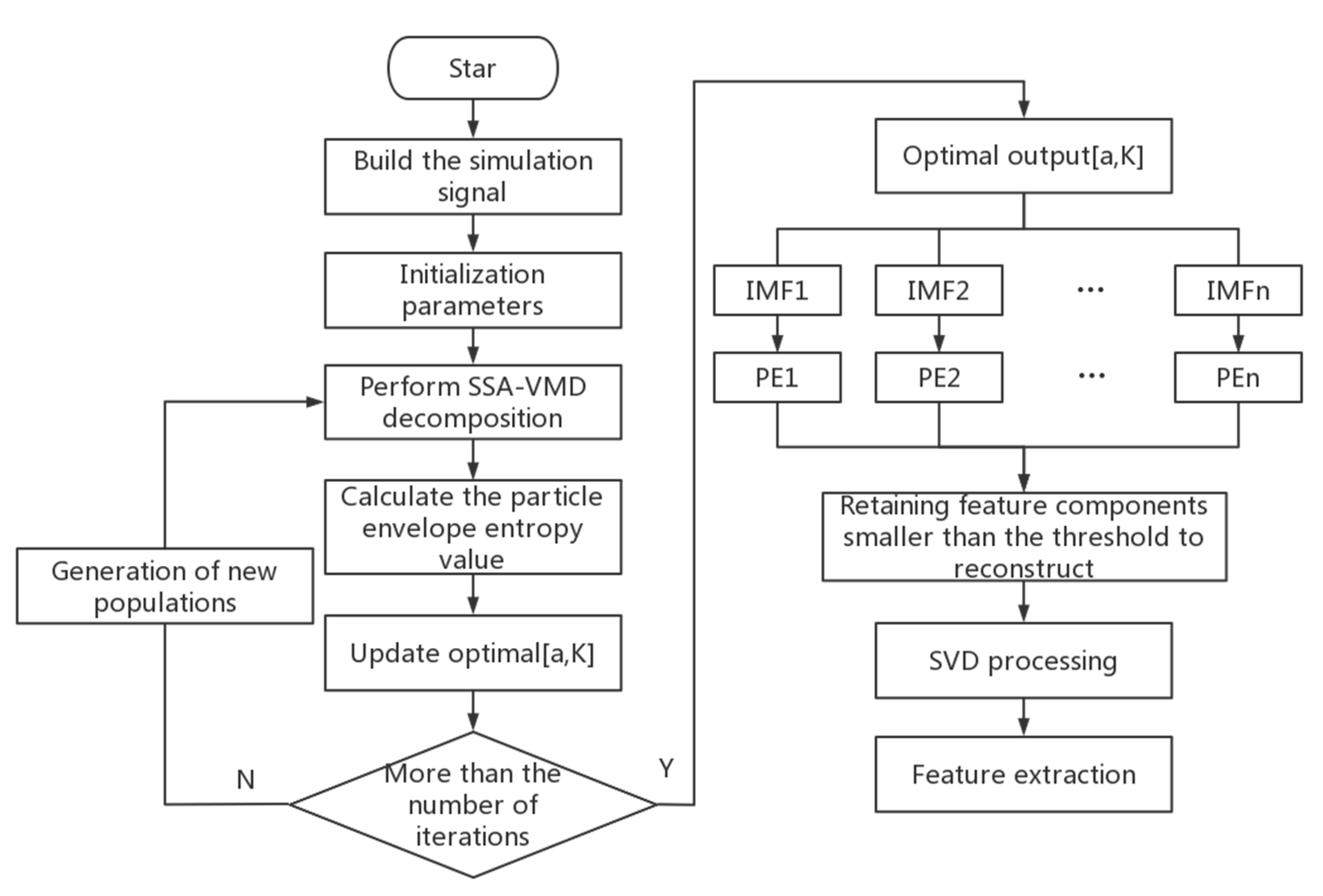

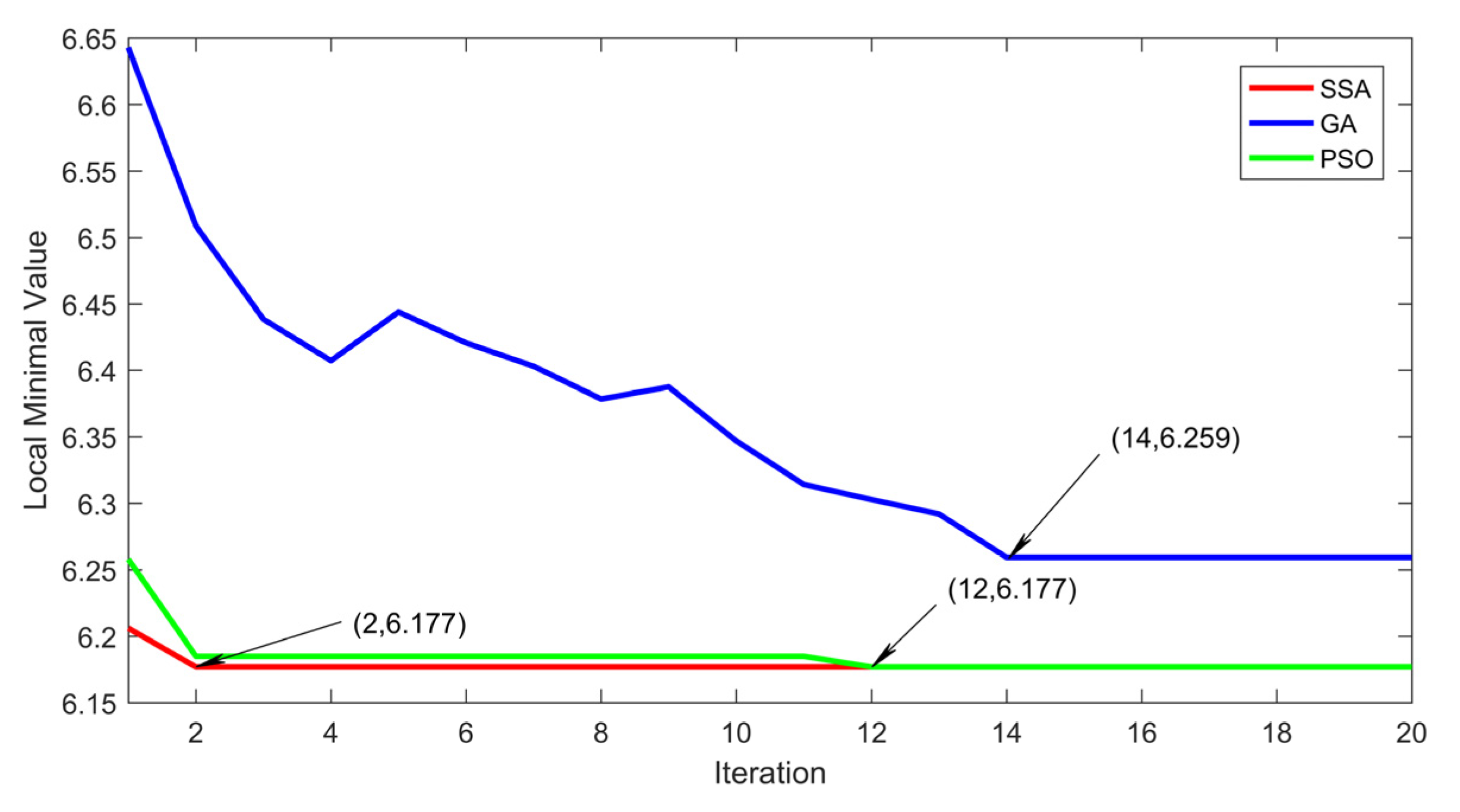
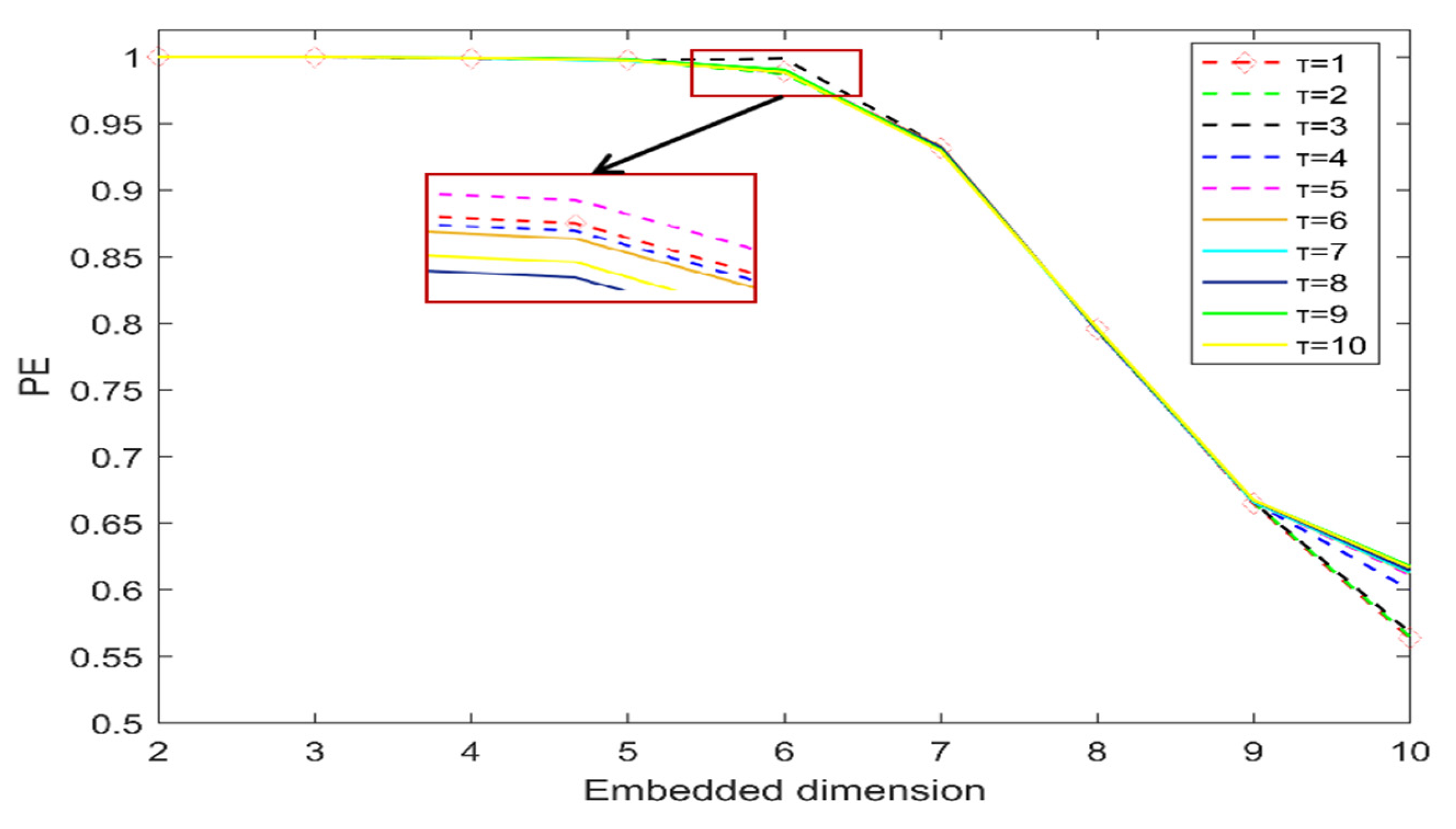
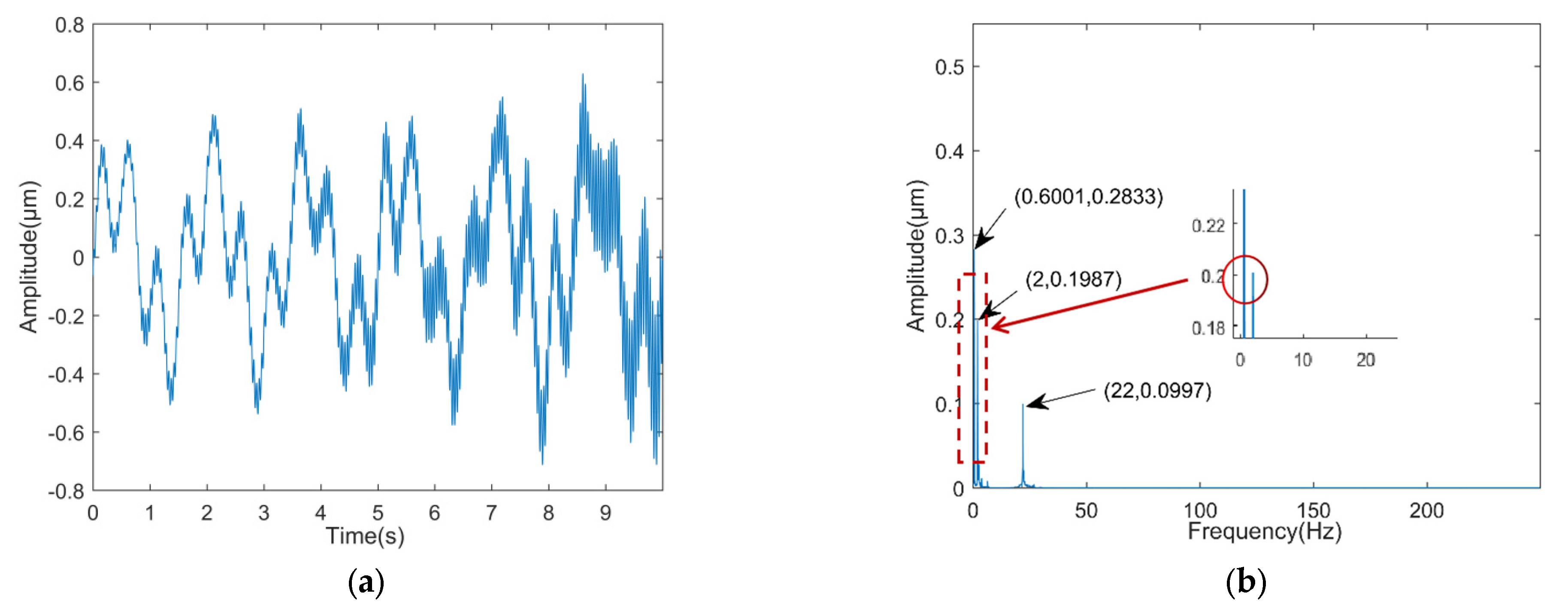
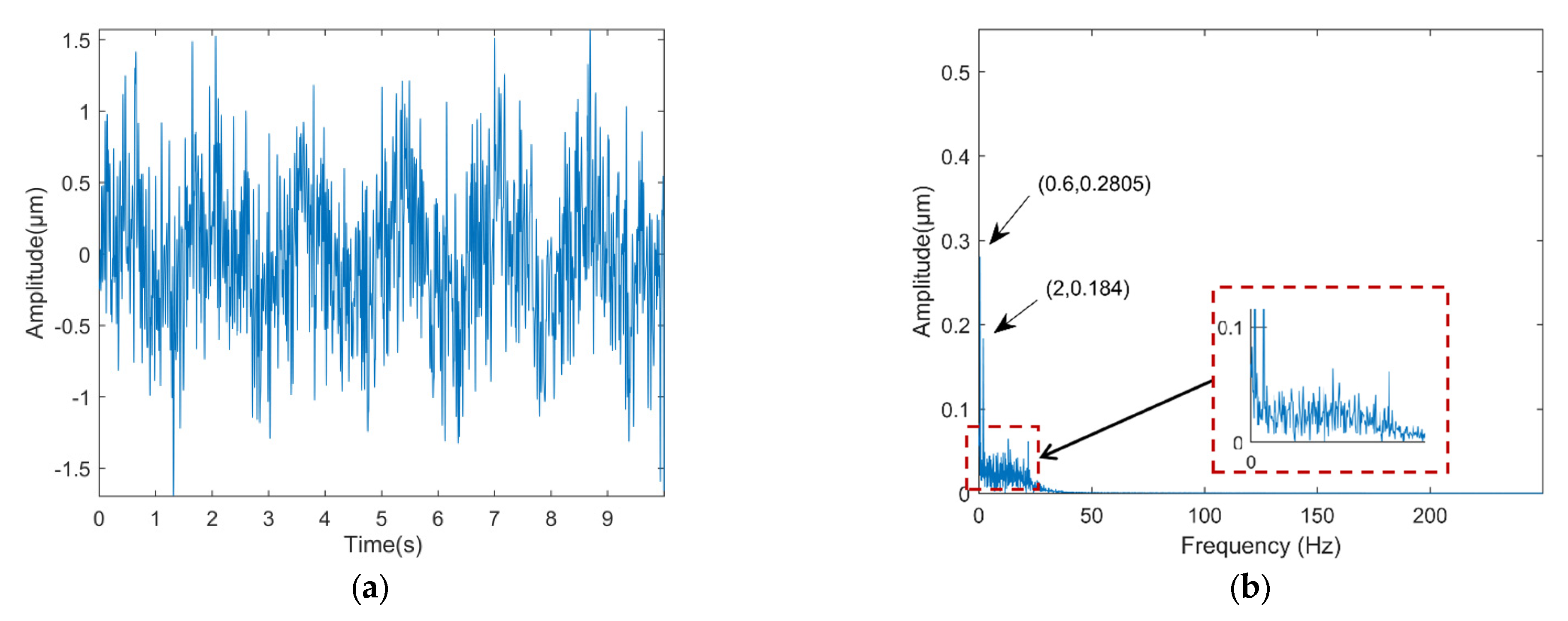

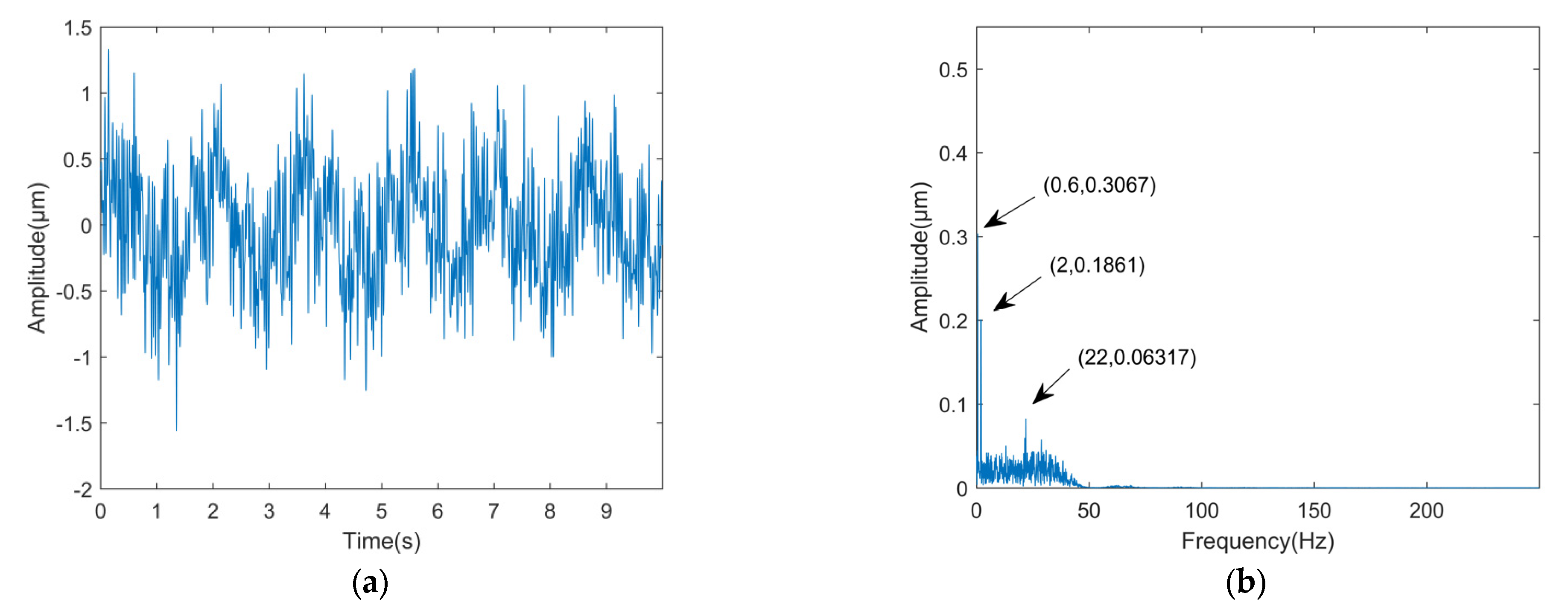

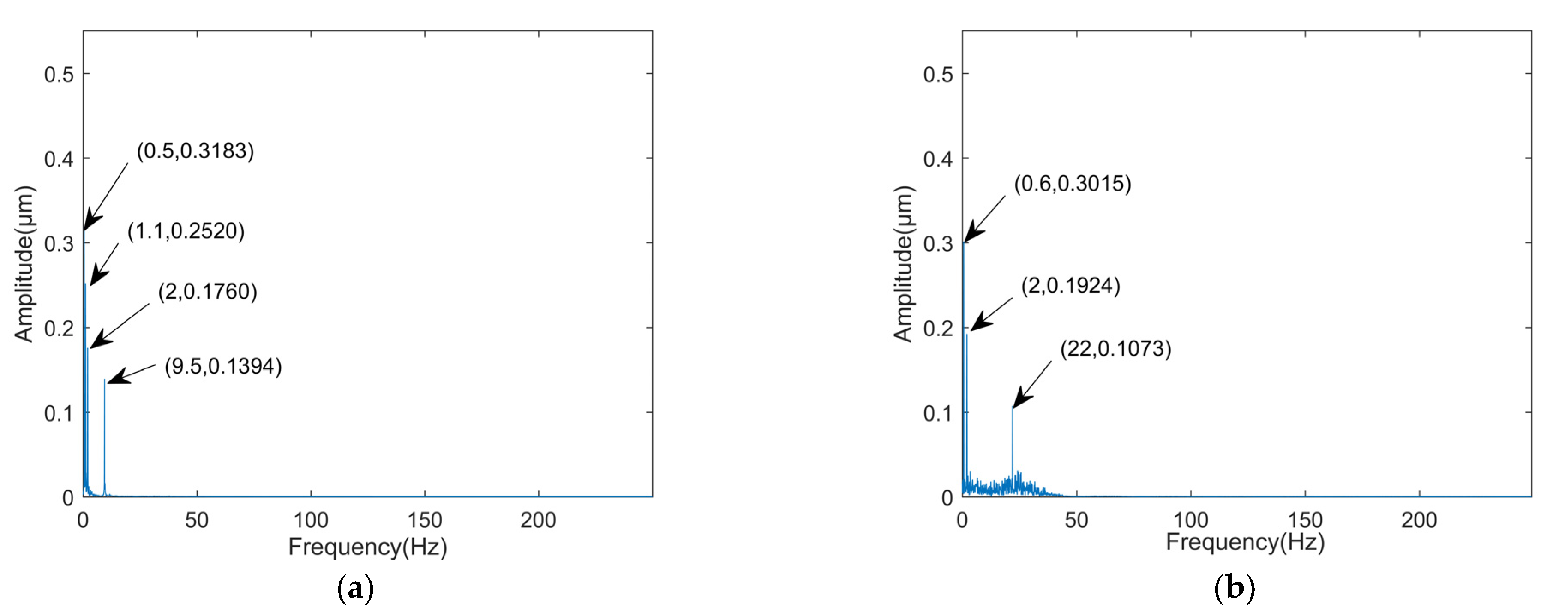


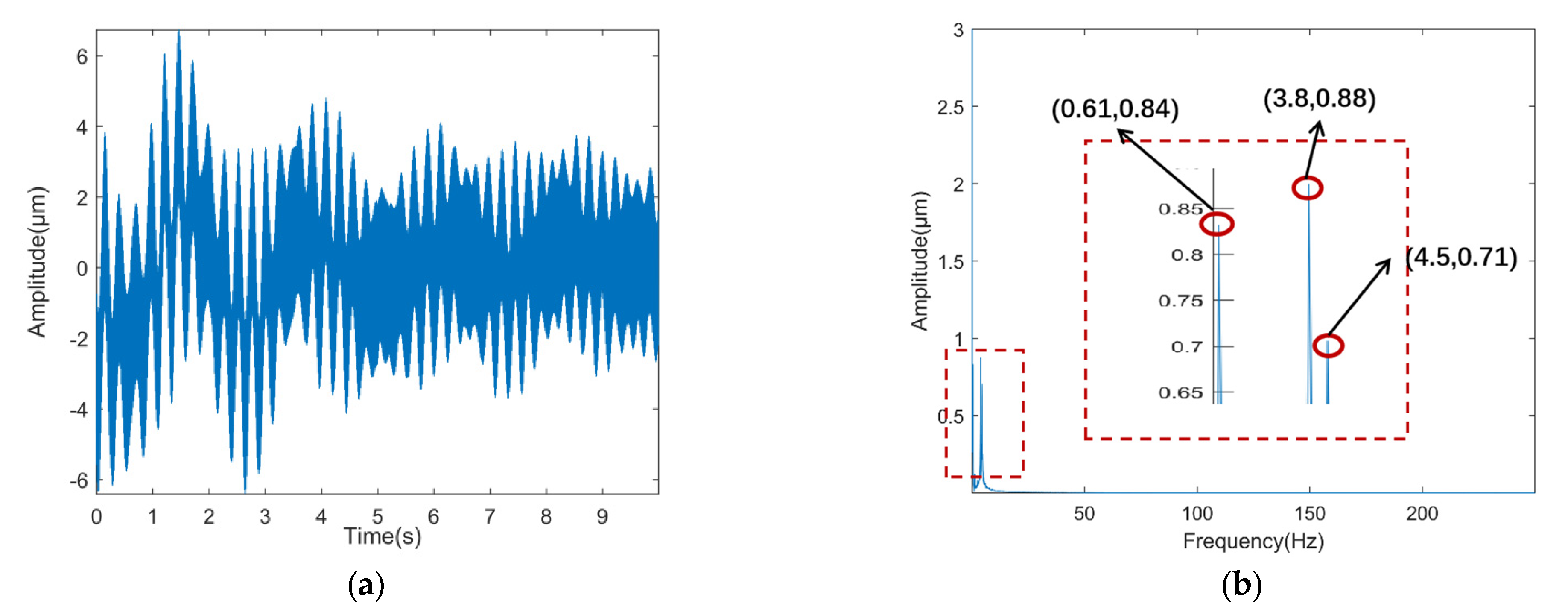
| Fitness Functions | [a, K] | Number of Iterations | Minimum Entropy Value | Running Time (s) |
|---|---|---|---|---|
| EE | [2853, 10] | 2 | 6.1766 | 4705 |
| PE | [2996, 10] | 2 | 0.4562 | 17150 |
| SE | [2898, 10] | 5 | 0.2221 | 10762 |
| Feature Extraction Methods | Correlation Coefficient | Mean Square Error |
|---|---|---|
| VMD-PE | 0.6210 | 0.3169 |
| VMD-SE | 0.4931 | 0.4368 |
| VMD-EE | 0.4945 | 0.4494 |
| Correlation Coefficient | Mean Square Error | |
|---|---|---|
| Noisy signals | 0.2428 | 1.0068 |
| CEEMD–PE | 0.5123 | 0.4227 |
| VMD–PE | 0.6210 | 0.3169 |
| ALIF–PE | 0.7024 | 0.2595 |
| ALIF–SVD | 0.9360 | 0.0940 |
| VMD–SVD | 0.9614 | 0.0732 |
| Signal | Correlation Coefficient | Mean Square Error |
|---|---|---|
| A | 0.9614 | 0.0732 |
| B | 0.9776 | 0.0901 |
| C | 0.9942 | 0.0285 |
Publisher’s Note: MDPI stays neutral with regard to jurisdictional claims in published maps and institutional affiliations. |
© 2022 by the authors. Licensee MDPI, Basel, Switzerland. This article is an open access article distributed under the terms and conditions of the Creative Commons Attribution (CC BY) license (https://creativecommons.org/licenses/by/4.0/).
Share and Cite
Ren, Y.; Zhang, L.; Chen, J.; Liu, J.; Liu, P.; Qiao, R.; Yao, X.; Hou, S.; Li, X.; Cao, C.; et al. Noise Reduction Study of Pressure Pulsation in Pumped Storage Units Based on Sparrow Optimization VMD Combined with SVD. Energies 2022, 15, 2073. https://doi.org/10.3390/en15062073
Ren Y, Zhang L, Chen J, Liu J, Liu P, Qiao R, Yao X, Hou S, Li X, Cao C, et al. Noise Reduction Study of Pressure Pulsation in Pumped Storage Units Based on Sparrow Optimization VMD Combined with SVD. Energies. 2022; 15(6):2073. https://doi.org/10.3390/en15062073
Chicago/Turabian StyleRen, Yan, Linlin Zhang, Jiangtao Chen, Jinwei Liu, Pan Liu, Ruoyu Qiao, Xianhe Yao, Shangchen Hou, Xiaokai Li, Chunyong Cao, and et al. 2022. "Noise Reduction Study of Pressure Pulsation in Pumped Storage Units Based on Sparrow Optimization VMD Combined with SVD" Energies 15, no. 6: 2073. https://doi.org/10.3390/en15062073
APA StyleRen, Y., Zhang, L., Chen, J., Liu, J., Liu, P., Qiao, R., Yao, X., Hou, S., Li, X., Cao, C., & Chen, H. (2022). Noise Reduction Study of Pressure Pulsation in Pumped Storage Units Based on Sparrow Optimization VMD Combined with SVD. Energies, 15(6), 2073. https://doi.org/10.3390/en15062073






